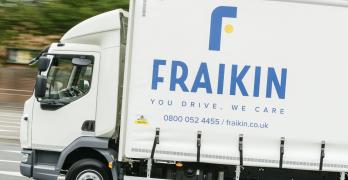HGVs and vulnerable road users: Manchester sets its sights on direct vision
- 03/04/24
- 5 min
When it comes to commercial vehicles working in urban environments, operators must do their utmost to keep all who share the road with them as safe as possible.
With more motorcycles, cyclists and pedestrians in our towns and cities, safely navigating the often congested streets can pose a significant challenge for larger vehicles – where any incident involving other road users could be tragic. The most recent UK government figures underline this fact, with motorcycles, cyclists and pedestrians accounting for the highest casualty rates on UK roads, alongside 48% of fatalities.

Both the automotive industry and legislators understand this unfortunate truth – it’s why London introduced the Direct Vision Standard (DVS), and now Greater Manchester has begun a consultation to assess whether a similar scheme could work there. However, while these attempts to improve road safety are an important step towards eradicating road deaths in the UK, their implementation poses potentially significant challenges for commercial operators.
What is DVS?
In London, all HGVs operating in the city require a DVS safety permit to avoid a daily fine of up to £550. The first scheme of its kind in the UK, it has been designed to encourage fleets operating within its jurisdiction – generally speaking, inside the M25 – to use vehicles which prioritise visibility in their design, thereby reducing the level of risk trucks pose to vulnerable road users. This, the Mayor of London says, is needed if London is to achieve its aim of eliminating all deaths and serious injuries resulting from road collisions in the city by 2041.
The visibility criteria can be met in two ways, either by fleets adopting new trucks with cabs specifically designed to maximise how much a driver can see from their seat – typically through installing additional windows or through lower cab designs – or by installing technologies that can help provide drivers with additional information of their surroundings, such as external cameras or pre-collision detection systems. The safest trucks – by Transport for London’s (TfL’s) criteria – combine both elements.
Vehicles are assessed on a 5-star rating system, from zero (poor) to five (excellent), with all HGVs already requiring at least a one-star rating to operate in and around London. Each vehicle must also have a DVS safety permit to prove they meet the minimum threshold, which is available free of charge via TfL.
However, the state of play will soon change – from October 2024 HGVs will need to be at least three-star rated to work in London, meaning fleets operating assets below this standard need to make changes to their fleet as soon as possible.
At Fraikin, we are already seeing both new and existing customers turning to our expert teams for assistance, advice and guidance to make sure their vehicles will be fit for purpose come October. We can help by supplying new trucks that already meet the three-star threshold, or by working to install what TfL terms a ‘Progressive Safe System’, which includes extra technologies to bring non-compliant vehicles up to code.
Our recent DVS update has a full run-down of the exact changes and expectations, but if you’re not sure on the rating for your vehicles, TfL has an online vehicle checker that quickly allows you to see whether your trucks meet the minimum 3-star threshold. From there, we can help you make the necessary changes.
Will Manchester actually commit to a DVS scheme?
Given the ongoing discourse around London’s DVS – the Road Haulage Association, for instance, has already flagged that a section of its member base feels that fleets will not be ready in time for October – news that Manchester may go a similar route will no doubt be a concern for some businesses. However, it is very early days.
Manchester’s consultation began in February, with the first stage concluding this month. However, considering the Mayor decided in December 2023 to indefinitely delay the introduction of the city’s Clean Air Zone – in part due to concerns from businesses operating in and around the city of the additional financial pressures it would cause – a vision-related initiative that also brings new economic challenges could lead to a similar stance.
At this stage though, Greater Manchester appears eager to explore all options. As part of the online consultation, it states that almost 10,000 people have been killed or suffered life-changing injuries on the city’s roads in the last 10 years. Its proposal therefore sees a potential DVS-like scheme included within a broader Vision Zero Strategy that – not unlike London – aims to eliminate road death and life-changing injury by 2040 and to achieve a 50% reduction by 2030.
As for what this could mean for your business, it is evident that more cities are beginning to follow in London’s footsteps and take road safety far more seriously. Even if your business is yet to be impacted by any DVS-style scheme, it may not be long until similar programmes roll out in other areas across the country.
Futureproofing your fleet today could be the cost-effective approach for your business’ future – HGVs meeting London’s DVS 3-star standard, for instance, are granted a ten-year licence to operate around the capital. Being proactive will ensure your fleet is prepared for what may come.
When discussing your next fleet refresh, why not talk to Fraikin about how to prioritise driver visibility?
Also worth reading

Labour’s Autumn Budget Uncertainty Highlights the Value of Contract Hire

Driver walkaround checks: Why they matter and how Fraikin is making them easier

